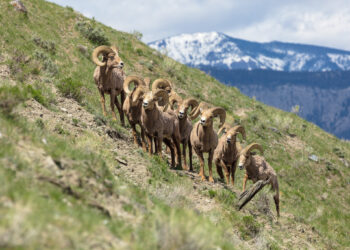By Kristin Gardner and Michael Richter EBS COLUMNISTS
In Big Sky, water is life. Understanding the movement of water within Big Sky’s aquifers—underground water systems—and how activities on the land impact their water quality is key to ensuring that the Gallatin River, its tributaries, our groundwater, and our drinking water remain healthy for the future.
Recently, the Montana Bureau of Mines and Geology Ground Water Investigation Program released findings from a study that examined groundwater flow dynamics, interactions with the Gallatin River, and the potential for pollution from septic systems to impact the river’s health.
The Gallatin River Task Force recommended the study in 2018 because of concerns that current and future riverside development using septic systems for wastewater treatment could have negative impacts on both the water quality of the Gallatin River and residential drinking water in the area. That, coupled with recurring algae blooms on the river—which resulted in a 2023 Environmental Protection Agency impairment designation on the Gallatin’s middle segment—created a need for understanding how excess nitrates are reaching the river.
The study area covers roughly five square miles south of the intersection of Big Sky at U.S. Highway 191 and Montana Highway 64, and includes a seven-mile section of the Gallatin River, from just north of Big Sky to roughly just south of the Rainbow Ranch. Also included in the study area are seven tributaries: Twin Cabin Creek, Beaver Creek, Porcupine Creek, Michener Creek, the West Fork of the Gallatin River (referred to as the West Fork), Levinski Creek and Dudley Creek.
The study team collected ground and surface water samples from 2019-2021, producing data that provides critical information about impacts of nearby wastewater systems on the river, the groundwater, and drinking water from individual and community wastewater disposal systems that serve this area.
The Upper Gallatin River Aquifer in the study area is identified as a shallow aquifer, with the groundwater and the surface water connected and exchanging water, making the UGA vulnerable to contamination from septic systems, and activities on the land surface, like fertilizer, pesticide application, or animal waste on pasture lands. This exchange of water varies depending on location, season, and climatic conditions, which means that in some places and times of year, the Gallatin River feeds the groundwater and in other places and times of year, the groundwater feeds the Gallatin River.
Not surprisingly, the study found that in developed areas west of the Gallatin, nitrate concentrations were more elevated than those in undeveloped areas east of the river. Concentrations ranged from 1.87mg/L – 5.84 mg/L, at least six times more than the Gallatin’s ecological standard of 0.3 mg/L for total nitrogen. EPA drinking water standards come in at 10 mg/L, as above 10 mg/l can be lethal to infants. The higher than ideal levels at several collection sites throughout the UGA most likely reflects the influence of septic effluent, horse feedlots, or over-applied fertilizers, which all have the ability to infiltrate contaminants into the aquifer.
What does all of this mean for next steps to keep the Gallatin healthy? One indisputable answer is a centralized wastewater system in the canyon, which would improve the health of the river, and protect drinking water in community wells. The study recommendations emphasize the importance of homeowners regularly testing their drinking water, and continued testing of our groundwater, which is essential in mitigating the changing conditions to the Gallatin.
Long-term monitoring at key locations on the Gallatin River will help identify seasonal and annual patterns of water exchange, which will be instrumental in understanding how groundwater interacts with surface water and where nutrients from wastewater are potentially impacting the river as growth continues.
Education, outreach and awareness is key; the community’s knowledge and role in helping keep our groundwater, drinking water, and the Gallatin healthy cannot be overstated. Homeowners’ understanding of the impacts of fertilizer use, and regular inspections of septic systems will go a long way in monitoring how nutrient loads are impacting the groundwater. Restoration projects that include improved wetlands to slow spring runoff flows will help reduce nitrogen through plant uptake and microbial processing that releases nutrients as gas back into the atmosphere.
These are all examples of critical steps, and they will all take time. But without them, the Gallatin is at risk of long term degradation, a risk that we should not be willing to take.
To learn more, find the report summary here, or join MBMG as they present the plan at the Upper Gallatin Open House scheduled for July 29 from 5-7 p.m. at Lone Peak High School.
Kristin Gardner is the chief executive and science officer of the Gallatin River Task Force, a Big Sky-based non-profit with a mission to protect, restore, and inspire stewardship of the Upper Gallatin River and the community water resources it sustains.
Michael Richter is a research specialist at the Montana Bureau of Mines and Geology, has lived in Big Sky for 30+ years, and is a former board member of the Gallatin River Task Force.













